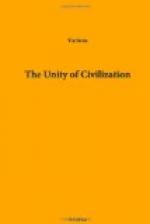If then we trace the development of Italian art, we shall first observe in such work as that of Masaccio in the Brancacci chapel at Florence just the same characteristic interest in the appearance and the varieties of human life as we find in the work of Boccaccio and Chaucer, and in the succession of the great Tuscan and Umbrian and Venetian painters and sculptors the same transformation of the bare reality of life by the magic of the imaginative sense of beauty and of passion as in the great drama. It is not, I think, merely fanciful to say that the real counterpart of the English and Spanish drama is to be found in the Italian painters and sculptors of the fifteenth and sixteenth centuries and in the Flemish artists of the early seventeenth. It is certainly true that each of these great artists had his own individual and distinctive genius, but the exquisite grace and beauty of the Umbrians and Tuscans have never been matched save in the romantic comedy of Shakespeare, and the presentation of the tragic passion of the human soul in King Lear has only once been equalled, and that is in the dreadful beauty and horror of the Night and Day, the Evening and the Morning of Michelangelo.
* * * * *
I do not think I need say much about the classical movement in art and literature, for we all know that it was international. It was begun by Petrarch, not indeed the Petrarch of the sonnets, for these are only a later form of the Troubadour lyric, and do not show any special trace of the classical influence, but the Petrarch whose letters were the first summons of Europe to a new and indefatigable work of the rediscovery of the ancient world. It was an Italian with whom the classical movement began, but it was only in the hands of two northern artists that it achieved a satisfying development in literature: the one a Frenchman, Racine, the other an Englishman, Milton. Neither are, I imagine, really classical at all, but of the two, Milton, as he was by far the more learned in ancient art, was also probably nearer to the ancient world both in form and in spirit.
Nor need I say anything about the deplorable ravages of the movement of good taste and common sense, which produced Boileau and, in some measure, Pope. It did some good, but far more evil, but happily it is long past and dead and done with, and we can afford to remember the little good and to forget the evil. Good or evil, it was at least very clearly a European and not a national movement.
I must ask you now to consider the extraordinary changes which passed over Europe in the eighteenth century, to trace the beginnings of that change which culminated in what we generally call the Romantic movement.
We all know, though not as well as we should, the work of Defoe, and beside Defoe there stands a painter whom also we all know, the great Hogarth. We all at least have read Robinson Crusoe, and we have probably all seen Hogarth’s engravings of the good and bad apprentices, and the series of paintings in the National Gallery known as the ‘Marriage a la mode’.




